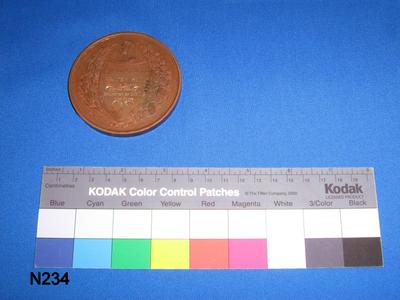Medallion
Production date
1879
See full details
Object detail
Description
Bronze, circular medal awarded to Walter Hill of the Brisbane Botanic Gardens. Medal features embossed decorations on both sides with engraved text on reverse.
Classification
NUMISMATICS (MEDALS AND OTHER) Civil Medals
Maker
Production date
1879
Measurements
Dia.73 x H7 mm
Media/Materials description
Bronze
Signature/Marks
At centre a steam traction engine above a horse, cow (reclining) and sheep within wreath comprised of grape vine and wheat ears. Wreathe also features agricultural implements including rake, scythe and spade. A bee's hive is positioned above the traction engie. Uppercase text is printed around the circumference of the medal across the top of the scene. Text reads "NATIONAL AGRICULTURAL & INDUSTRIAL ASSOCIATION OF QUEENSLAND". Below the bee's hive is a ribbon containing uppercase text - " BY INDUSTRY".
Crowned bust of Queen Victoria facing left and positioned above a shield which is inscribed 'AWARDED TO \ WALTER HILL \ BOTANIC GARDENS \ EXTRA PRIZE \ COLLECTOR OF CEREALS \ AND ROOTS \ 1879. The shield is positioned within a wreath comprised of grape vine and wheat ears.
WALTER HILL. \ EXTRA PRIZE \ FOR \ GREYHOUND \ SURPRISE \ 1879.
Crowned bust of Queen Victoria facing left and positioned above a shield which is inscribed 'AWARDED TO \ WALTER HILL \ BOTANIC GARDENS \ EXTRA PRIZE \ COLLECTOR OF CEREALS \ AND ROOTS \ 1879. The shield is positioned within a wreath comprised of grape vine and wheat ears.
WALTER HILL. \ EXTRA PRIZE \ FOR \ GREYHOUND \ SURPRISE \ 1879.
History and use
This medallion was awarded by the National Agricultural and Industrial Association of Queensland to Walter Hill, the first Superintendant/Curator of the Brisbane Botanic Gardens from 1855-1881. Hill’s interest was primarily in economic plants and crops and this medal was presented to him in 1879 for his collection of, and research into, cereal and root crops.
The medallion designer, R Capner, was an Englishman who lived and worked in Brisbane for over thirty years. In England he had designed the Prince Alfred Memorial Medal, and was noted here in Queensland for the Queensland colonial seal and police and railway service medal designs.
The National Agricultural and Industrial Association of Queensland was formed in 1875, and its goal was to bring together the cultures of country and city in celebration of the diversity of Queensland industry and lifestyle. The first show was the Intercolonial Exhibition of 1876, held on the land at Bowen Hills purchased by the Association. A public holiday was declared and the show was extremely popular, drawing crowds of 17 000, when Brisbane’s total population was only 22 000 at the time.
The ‘Ekka’, as it is now affectionately known, is a 10 day annual festival, officially titled the ‘Royal Queensland Show’ since 1921 when King George V warranted the ‘Royal’ prefix.
Uploaded to the Web 27 May 2011.
The medallion designer, R Capner, was an Englishman who lived and worked in Brisbane for over thirty years. In England he had designed the Prince Alfred Memorial Medal, and was noted here in Queensland for the Queensland colonial seal and police and railway service medal designs.
The National Agricultural and Industrial Association of Queensland was formed in 1875, and its goal was to bring together the cultures of country and city in celebration of the diversity of Queensland industry and lifestyle. The first show was the Intercolonial Exhibition of 1876, held on the land at Bowen Hills purchased by the Association. A public holiday was declared and the show was extremely popular, drawing crowds of 17 000, when Brisbane’s total population was only 22 000 at the time.
The ‘Ekka’, as it is now affectionately known, is a 10 day annual festival, officially titled the ‘Royal Queensland Show’ since 1921 when King George V warranted the ‘Royal’ prefix.
Uploaded to the Web 27 May 2011.
Associated person
Registration number
N234



